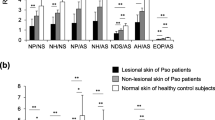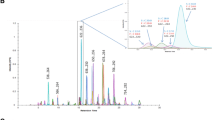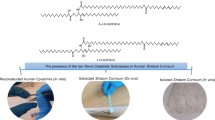Abstract
The stratum corneum (SC) consists of corneocytes surrounded by a neutral lipid-enriched intercellular matrix. Ceramides represent approximately 50% of intercellular lipids, and play important roles in retaining epidermal water. The SC also contains covalently bound ceramides, which are thought to play a crucial role in the formation of lamellar structures, and are involved in maintaining skin barrier function. A previous report showed that levels of free ceramides in human SC changed with the seasons and age, although whether the content of different species of covalently bound ceramides also underwent such temporal changes was unclear. Here, SC samples were taken from 99 healthy individuals of different ages (24–64 years) and during different seasons. The content of different molecular species of covalently bound ceramides in the samples was quantified using HPLC–MS/MS. The levels of total covalently bound ceramides (Total-Cers) significantly decreased approximately 50% in autumn and winter, compared with that of spring and summer. The levels of covalently bound ceramides containing saturated fatty acids (SFA-Cers) in the spring and summer were approximately 2.3-fold higher than that seen in autumn and winter, whereas the level of covalently bound ceramides containing unsaturated fatty acids (USFA-Cers) in spring and summer were approximately 1.6-fold higher than that in autumn and winter. Furthermore, the ratio between SFA-Cers and USFA-Cers was significantly lower in spring and summer than in autumn and winter. The levels of SFA-Cers, but not USFA-Cers, were significantly lower in individuals ≥ 50 years old compared to those who are 30- and 40-years old in the spring. Our study showed for the first time that, similar to free ceramides, the level of covalently bound ceramides changed with the seasons. However, age-related changes in covalently bound ceramide content were limited in that only the amount of SFA-Cers in the spring was lower in older individuals.




Similar content being viewed by others
References
Abe T, Mayazumi J, Kikuchi N, Arai S (1980) Seasonal variations in skin temperature, skin pH, evaporative water loss and skin surface lipid values on human skin. Chem Pharm Bull (Tokyo) 28:387–392
Bouwstra JA, Gooris GS, Dubbelaar FE, Ponec M (2002) Phase behavior of stratum corneum lipid mixtures based on human ceramides: the role of natural and synthetic ceramide 1. J Investig Dermatol 118:606–617
Conti A, Rogers J, Harding C, Rawlings A (1996) Seasonal influences on stratum corneum ceramide 1 fatty acids and the influence of topical essential fatty acids. Int J Cosmet Sci 18:1–12
Galzote C, Estanislao R, Suero M, Khaiat A, Mangubat M, Moideen R, Tagami H, Wang X (2014) Characterization of facial skin of various Asian populations through visual and non-invasive instrumental evaluations: influence of seasons. Skin Res Technol 20:453–462
Hachem J-P, Crumrine D, Fluhr J, Brown BE, Feingold KR, Elias PM (2003) pH directly regulates epidermal permeability barrier homeostasis, and stratum corneum integrity/cohesion. J Investig Dermatol 121:345–353
Hachem J-P, Houben E, Crumrine D, Man M-Q, Schurer N, Roelandt T, Choi EH, Uchida Y, Brown BE, Feingold KR (2006) Serine protease signaling of epidermal permeability barrier homeostasis. J Investig Dermatol 126:2074–2086
Hachem J-P, Man M-Q, Crumrine D, Uchida Y, Brown BE, Rogiers V, Roseeuw D, Feingold KR, Elias PM (2005) Sustained serine proteases activity by prolonged increase in pH leads to degradation of lipid processing enzymes and profound alterations of barrier function and stratum corneum integrity. J Investig Dermatol 125:510–520
Imokawa G, Abe A, Jin K, Higaki Y, Kawashima M, Hidano A (1991) Decreased level of ceramides in stratum corneum of atopic dermatitis: an etiologic factor in atopic dry skin? J Investig Dermatol 96:523–526
Ishikawa J, Shimotoyodome Y, Ito S, Miyauchi Y, Fujimura T, Kitahara T, Hase T (2013) Variations in the ceramide profile in different seasons and regions of the body contribute to stratum corneum functions. Arch Dermatol Res 305:151–162
Macheleidt O, Kaiser HW, Sandhoff K (2002) Deficiency of epidermal protein-bound omega-hydroxyceramides in atopic dermatitis. J Investig Dermatol 119:166–173
Masukawa Y, Narita H, Sato H, Naoe A, Kondo N, Sugai Y, Oba T, Homma R, Ishikawa J, Takagi Y (2009) Comprehensive quantification of ceramide species in human stratum corneum. J Lipid Res 50:1708–1719
Masukawa Y, Narita H, Shimizu E, Kondo N, Sugai Y, Oba T, Homma R, Ishikawa J, Takagi Y, Kitahara T (2008) Characterization of overall ceramide species in human stratum corneum. J Lipid Res 49:1466–1476
Mauro T, Grayson S, Gao WN, Man M-Q, Kriehuber E, Behne M, Feingold KR, Elias PM (1998) Barrier recovery is impeded at neutral pH, independent of ionic effects: implications for extracellular lipid processing. Arch Dermatol Res 290:215–222
Meguro S, Arai Y, Masukawa Y, Uie K, Tokimitsu I (2000) Relationship between covalently bound ceramides and transepidermal water loss (TEWL). Arch Dermatol Res 292:463–468
Morifuji M, Oba C, Ichikawa S, Ito K, Kawahata K, Asami Y, Ikegami S, Itoh H, Sugawara T (2015) A novel mechanism for improvement of dry skin by dietary milk phospholipids: effect on epidermal covalently bound ceramides and skin inflammation in hairless mice. J Dermatol Sci 78:224–231
Rogers J, Harding C, Mayo A, Banks J, Rawlings A (1996) Stratum corneum lipids: the effect of ageing and the seasons. Arch Dermatol Res 288:765–770
Shimotoyodome Y, Tsujimura H, Ishikawa J, Fujimura T, Kitahara T (2014) Variations of ceramide profile in different regions of the body of Japanese females. J Jpn Cosmet Sci Soc 38:3–8
Song E, Lee J, Park J, Kim H, Kim N, Byun K, Choi G, Moon T (2015) A study on seasonal variation of skin parameters in Korean males. Int J Cosmet Sci 37:92–97
Tagami H (1998) Stratum Corneum as a Barrier in the Skin. Jpn J Dermatol 108:713–727
Takagi Y, Nakagawa H, Kondo H, Takema Y, Imokawa G (2004) Decreased levels of covalently bound ceramide are associated with ultraviolet B-induced perturbation of the skin barrier. J Investig Dermatol 123:1102–1109
van Smeden J, Hoppel L, van der Heijden R, Hankemeier T, Vreeken RJ, Bouwstra JA (2011) LC/MS analysis of stratum corneum lipids: ceramide profiling and discovery. J Lipid Res 52:1211–1221
Wertz PW (1992) Epidermal lipids. Semi Dermatol 11:106–113
Wertz PW, Swartzendruber DC, Kitko DJ, Madison KC, Downing DT (1989) The role of the corneocyte lipid envelopes in cohesion of the stratum corneum. J Investig Dermatol 93:169–172
Author information
Authors and Affiliations
Corresponding author
Ethics declarations
Conflict of interest
The authors declare that they have no conflict of interest.
Ethical approval
All procedures performed in these studies involving human participants were in accordance with the ethical standards of the institutional research committee and with the 1964 Helsinki declaration and its later amendments or comparable ethical standards.
Informed consent
Informed consent was obtained from all individual participants included in the study.
Rights and permissions
About this article
Cite this article
Fujiwara, A., Morifuji, M., Kitade, M. et al. Age-related and seasonal changes in covalently bound ceramide content in forearm stratum corneum of Japanese subjects: determination of molecular species of ceramides. Arch Dermatol Res 310, 729–735 (2018). https://doi.org/10.1007/s00403-018-1859-z
Received:
Revised:
Accepted:
Published:
Issue Date:
DOI: https://doi.org/10.1007/s00403-018-1859-z




